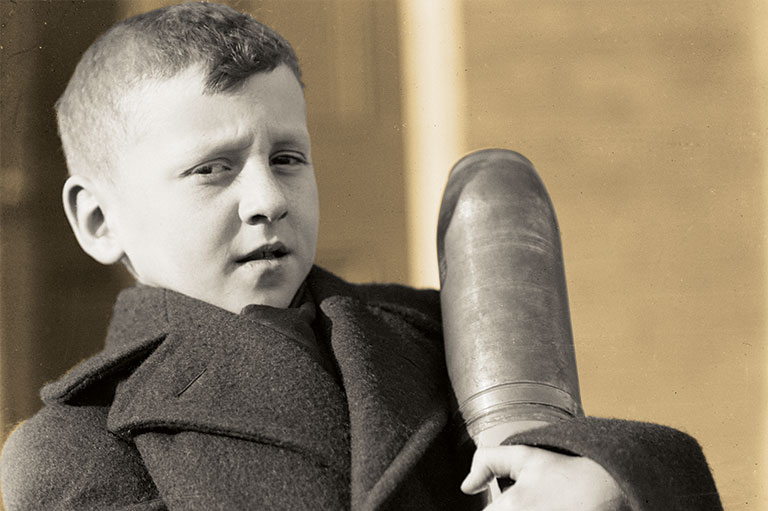The Raid on Blécourt

On September 27, 1918, the Canadian Corps was the left hook of an attack against the strategic city of Cambrai, France. By the night of September 28th, the 4th Canadian Division had attacked northwest of the city and reached the Cambrai-Douai road near the village of Sancourt.
One day later, the 4th Division was to cross the Cambrai-Douai road and capture the fortified villages of Sancourt, then Blécourt, and possibly points beyond, depending how the plan unfolded. Things did not go as hoped for.
That day the 4th Division attacked with its 72nd Battalion (Seaforth Highlanders of Canada) against Sancourt. At 8:00 a.m. an understrength 72nd Battalion (the Battalion had been heavily engaged already on September 27) went over the top with sixteen officers and 373 other ranks.

Its B company, including Lt. Joseph (Joe) McKay Knight entered the village of Sancourt and cleaned it out with the help of another company and collected 230 prisoners by 9:00 a.m. Knight’s B company (which took time to reorganise) then pushed on towards Blécourt and reached a railway embankment between the two villages.
These soldiers, holding the railway embankment between Sancourt and Blécourt, were the most advanced Canadian troops that day and were in a tenuous position: They faced intense machinegun fire from Blécourt itself as well as from the high ground on a flank. Troops on their left and right had failed to keep up with them.
It seemed to any observer that this would be the limits of the advance for the 72nd Battalion that day. Then, something remarkable happened: Knight and five men, including the Lewis gunner Charles Creighton Graham, crept up, according to the 72nd Battalion official history, to “the bed of a partially dried-up stream and entered the heavily garrisoned village. Working with bewildering speed and audacity they proceeded to mop up Blécourt. Placing a Lewis gun so as to sweep the village square, Lt. Knight and his party bombed cellars in the vicinity, and took, unaided, at the point of the bayonet, 150 prisoners. By this time all of Lt. Knight’s men had been wounded. Their prisoners, who outnumbered their captors about 25 to 1, seeing the weakness of the attacking force, began to dribble away. Notwithstanding this, Lt. Knight’s party rounded up 80 prisoners, thus accomplishing what was probably one of the most gallant achievement in the history of the Battalion.”


I visited Blécourt and the railway embankment still exists, as does the partially dried-up stream. I went into the village where the stream enters the village near a little square. Nearby is a pigeon coop that existed in 1918 and survived the war. I went past the coop to find the main square with a large farm, which is also contemporary to the battle. I imagined Knight barking orders and men kicking in basement windows and hurling bombs.
Another report, this time from an unidentified trench newspaper clipping (found with Knight’s private papers) states that “a lieutenant and four men actually entered Blécourt, where 100 Boches surrendered. These they marched in columns of four, and the prisoners were astounded to find that there was no further support. All four men were wounded, but they brought in their capture.”

I always wondered how this “marching in columns of four” of eighty-odd prisoners would be possible. But when in Blécourt I found one secondary road leading to the Canadian lines was backed by the backs of buildings and tall brick fences. No windows and few openings opened on to this road. It’s quite possible that Knight shepherded his catch down this road back to the railway embankment.
After the exploit, the Germans began to counter-attack. According to the official history of the Battalion: “About noon, the pressure of the German counter-attacks began to make itself felt along the line. These counter-attacks developed chiefly in the form of small bodies of the enemy, who, working their way forward, kept a steady pressure up along the whole front. For over two hours these counter-attacks were held up before our positions by means of gun and rifle fire, but as fresh German units were flung into the fight, to strain the line, particularly on the flanks, reached a most critical stage.” The 72nd battalion abandoned the position and retired to the western edge of Sancourt.
Quoting again the unidentified newspaper clipping, the bitterness of the men who entered Blécourt is apparent: “‘This is the first time we have had to chuck anything we have got hold of,’ they remarked, referring to Blécourt.’’
In a moment of self-indulgence, Knight wrote in the margin of this clipping, “I was the Officer.”

Knight was awarded his second Military Cross for his bravery on September 27 and 29, 1918. Personally, I think he deserved the Victoria Cross for his action at Blécourt.
Knight was originally from Knightington, a hamlet near Eganville, Ontario, an area now known as Fourth Chute. His father owned a sawmill in Knightington. Knight was one of ten children, and four of the boys, including Knight, moved to western Canada. He was in British Columbia working as a miner when war broke out. He enlisted in British Columbia.
Private Charles Creighton Graham was not quite twenty when he enlisted with the Canadian Expeditionary Force in January 1916.
Graham was wounded twice while fighting in France, the first time being shot in the right knee in November 1917, the other, in 1918, when he was awarded the Distinguished Conduct Medal for his part on the Raid of Blécourt, September 29, 1918. Graham died in a veteran’s hospital in Vancouver on October 23, 1966, at the age of sixty-seven.
Themes associated with this article
Advertisement
1914-1918: The War Ends

Canada’s History Archive, featuring The Beaver, is now available for your browsing and searching pleasure!

The war that changed Canada forever is reflected here in words and pictures.











